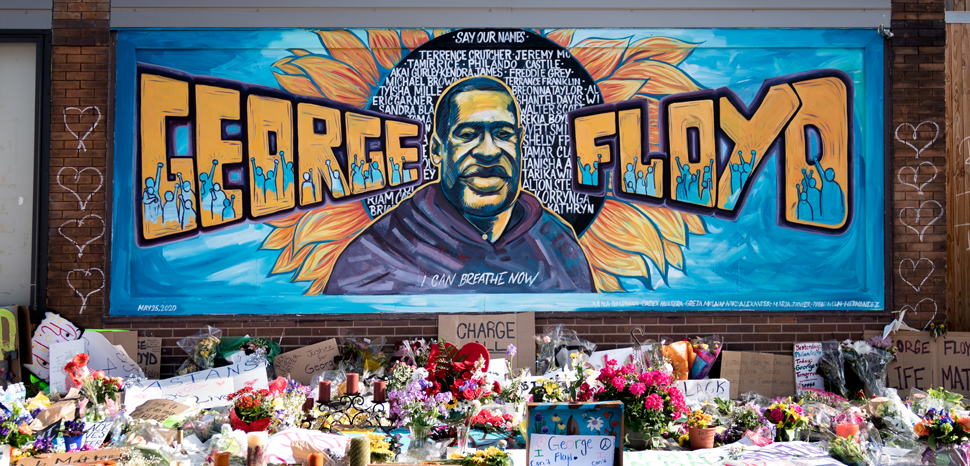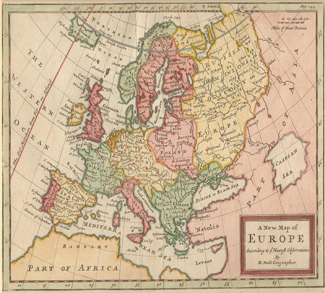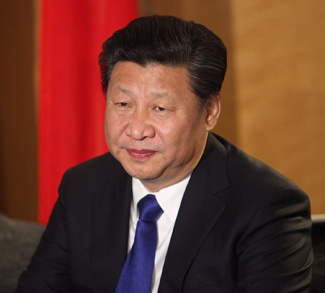At 10:00 pm, riot police began gathering a little over a mile away from the thousands of protesters gathered outside New York City’s Barclay’s Center. A few stragglers had broken through some makeshift barricades and breached the arena’s perimeter, agitating the NYPD as they moved into the area to disperse the crowd. The following scene was as familiar as it was frightening, but the protesters returned volleys of tear gas with rocks and rubble.
Pushed back to the neighborhood near Fort Greene, the situation turned desperate. A few of the dissidents rushed the police line, emboldening a few others to follow suit. Helicopters swarmed overhead and the smell of chemicals perpetrated the air as a New York Times reporter rushed through the mob to find out what happened. “It was kind of his mistake,” Jason Phillips, a local resident told the reporter. “But they were trying to push him back, and as they pushed him back, he slipped, and they took that as some type of threat.”
Friday night ended with 72 arrests and a few detentions, but other cities around the country weren’t so lucky. Violent agitators broke into the lower level of the CNN center in Atlanta Georgia that same night, trying to infiltrate and presumably loot the 5th Precinct headquarters for the city police located inside. In Houston, protesters streamed onto public highways and streets carrying signs like, “End Police Brutality.” Even in Washington, the White House was placed on lockdown after crowds began gathering outside and clashing with local police.
It’s extremely doubtful that even the most uninterested individual is at a loss as to why these demonstrations are popping everywhere. The video of Minneapolis Police Officer Derek Chauvin and his colleagues murdering George Floyd, an African-American with no severe previous criminal background, based purely on the accusation that he had given a local deli a counterfeit $20 bill, has become an international sensation in just days. Floyd is clearly seen begging for his life as Chauvin places his knee directly on his neck until he finally passes out from lack of oxygen. The resulting riots and protests that have rocked the nation represent a very clear mentality among not just blacks, but those of all ethnicities, that law enforcement officials must be held to a higher standard.
The tone being struck by the protesters however is much more diverse, both physically and philosophically, than those of the past. It’s easy to see just by turning on the television that these protests are populated almost equally between members of all races, not just African-Americans. And the complaints being heard aren’t just about Mr. Floyd, but also other victims such as Kentucky EMT Breonna Taylor, who was gunned down in her home by police after being noted as a person-of-interest in a nearby crime that had happened earlier in the day. As of the publication of this article, the officers involved still haven’t faced any charges.
These terrible tragedies are real life examples of sometimes inhumane, cold hard numbers and statistics. Nonetheless, they paint a grimly accurate picture of the challenges minorities face in America. African-Americans are three times more likely to be killed in police altercations than whites, despite the fact that the vast majority of those incidents involve the African-American being unarmed. Blacks, while making up a significantly smaller portion of the population in Oklahoma than in Georgia, are actually six times more likely to be killed by police in Oklahoma than in the peach state. But that isn’t the most worrisome number: 99% of all police killings between 2013-2019 did not result in any criminal charges for the officer involved.
Still, it’s important to note that not everything is so cut-and-dry. Even the most casual viewer of the events unfolding across the country can easily surmise a clear reality, that the situation’s complicated nature makes any possible conclusion at best, critically weak. The stories of pain and terror that have flooded our living rooms for days all deserve respect, no matter who tells them.
One of those stories is from Erika Atson, who was part of a peaceful protest that took place outside a government office in downtown Minneapolis. At 20 years old, she has already felt the very real problem of police brutality personally. A couple years back in a case closed by the city, her 14-year-old and 11-year-old brothers were violently tackled and subdued by policemen on suspicion of possessing illegally obtained firearms. Obviously, as in so many cases, the young boys were completely innocent. That day stuck with Erika, as with similar instances that have affected African-Americans for centuries now.
“We don’t want to be here fighting against anyone. We don’t want anyone to be hurt. We don’t want to cause any damages,” she told Politico. “We just want the police officer to be held accountable.” Only hours later, the peaceful protest came into confrontation with law enforcement after they forcefully tried to disperse the crowd. Ms. Atson’s ultimate fate still remains unclear.
To the credit of both the local and federal government, response to Floyd’s death was incredibly fast. The process of building a case file robust enough to bring against Chauvin was expedited at a record rate, and within days the city had not only fired him, but had brought criminal charges. President Donald Trump, a politician criticized constantly for riling up racial tensions, announced via Twitter that the FBI and Justice Department would directly investigate the incident and bring the full brunt of the law down on the officers who were at the scene. But some, including Floyd’s own family, say the repercussions are not nearly as severe as they should be.
Chauvin currently is the only one facing charges as the other officers at the scene are still undergoing review. As of the publication of this article, Chauvin is only being charged with third-degree murder and second degree manslaughter. Third-degree murder does not require an intent to kill, according to state legal statute, only that the perpetrator caused someone’s death in a dangerous act “without regard for human life.” Floyd’s family has stated strongly they believe the charge should be much stronger.
Unfortunately, it seems that the brutality these protesters are so passionately standing up against has been on full display as the demonstrations grow in velocity and size. In Louisville, Kentucky, TV Reporter Kaitlin Rust of television station WAVE was hit by incoming pepper-balls and rubber bullets while broadcasting, crying out in terror, “I’ve been shot!” “They’re aiming at us,” Rust said. “They’re aiming directly at us.” she continued.
In New York City, a cop car is seen on video recklessly charging into a crowd of protesters protected by a barrier before slowly backtracking. In Minneapolis, CNN reporter Omar Jimenez along with his crew were arrested by local police even after repeatedly offering to move out of the way. “We can move back to where you like. We are live on the air here. … Put us back where you want us. We are getting out of your way — wherever you want us (we’ll) get out of your way,” Jimenez said to police before he was led away. “We were just getting out of your way when you were advancing through the intersection,” Jimenez continued. The reporter and the crew were later released as the result of direct intervention from Governor Tim Waltz.
Perhaps most disturbing of all, Twin Cities resident Tanya Kerssen shared a now viral video on social media that shows her and some friends being fired upon by Minnesota National Guardsmen as they swept streets in the Whittier Neighborhood. While the officers did order Kerssen inside her home, it’s noteworthy that she only on her own front porch; when she didn’t comply, a member of the group shouted, “Light em’ up!” as they began firing non-lethal projectiles at her. The video cuts with Kerssen fleeing inside her home as the Guardsmen continue to fire.
Arguably, the real corrosion of the system is not taking place in the streets, but on the airwaves. TV panels all across syndicated television services, per usual, are treating the crisis we face like a debate over Sunday night football. The legacy of the great Martin Luther King Jr. has probably been talked about more in the last week than in the entirety of 2019; and most of what is mentioned is taken out of context or is clearly inaccurate. MLK was indeed a committed pacifist; however, in his own way he was a radical. His approach to civil disobedience was not based on gaining public approval or making good headlines. On the contrary, upon his death Dr. King’s national disapproval rating was at 75%.
The Civil Rights icon, along with his followers, were no strangers to disobeying police orders. The preacher was arrested for breaking several local laws during his career, ranging from traffic violations to loitering. King by no means was against breaking a law if he felt it unjust; a valuable lesson we can all take heed of particularly during this difficult time.
While lawless looting and rioting that lacks any purpose beyond selfishness is condemnable in all situations, those who flatly believe that open insurrection against a government is ineffective clearly do not understand history. American history is cluttered with examples of change occurring through instability, including the Boston Tea Party, the Stonewall Riots, the Pennsylvania Mutiny, and the Kent State protests. Time after time, democratic governments have shown their response to a problem is always linked to the dissatisfaction of the people.
No major movement to achieve a sweeping, cultural change has ever been 100% peaceful. The Civil Rights movement in the 1950s and 1960s was constantly under siege from both a legal perspective and a political one. The very founding of our nation started with the Boston Massacre, a riot where Americans openly began attacking the policing British forces in the city. Shortly thereafter, a radical independence group called the Sons of Liberty stormed aboard a vessel in Boston harbor to protest a tax hike on tea, and ended up destroying upwards of 1 million dollars of property in a single night. Even future president George Washington at the time called the instigators, “mad” for being so openly hostile and uncivil.
So maybe we should ask ourselves: Why do we as a country selectively praise violent riots, looting, and protesting for the liberation of our pocketbooks, but not for the lives of our very citizens? Indeed, there is a strong argument to be made that many of the individuals who feign horror at the sight of vandals breaking into local supermarkets and destroying public property out of anger obviously lack any authority to condemn such actions as universally unjustified; as clearly they find it more than tolerable, in fact patriotic, depending on the circumstances.
Riots and protests work; they may not always be the correct course of action, but that doesn’t nullify the pressure they can usually inflict on national governments.
The nation, maybe for the first time in decades, is clearly looking inward as to how to permanently solve the problem of racial injustice. A good place to start would be to truly understand the mindsets of the men and women who have been the victims of inequality for generations.
It is the natural result of the human condition that leads us to anger; to hate and to take vengeance. The overwhelming rush of adrenaline, noradrenaline, and cortisol clouds usually solid judgement, and leads to an abundance of dauntless audacity. We convince ourselves our rage entitles us to courses of action we normally wouldn’t seek; it blinds the better angels inside every one of us to the inescapability of consequence.
Minneapolis doesn’t have to burn. Neither does Atlanta, LA or Detroit. The inevitably of violence is a myth; peace will always be a viable option. Every single protester, whether his motivations are personal or moral, can make the choice to honor Mr. Floyd’s life by choosing love over hate.
But make no mistake: George Floyd’s death was also the result of a choice. A choice that didn’t have to be made. And sometimes, choices have repercussions. Perhaps a more constructive and efficient way of handling the carnage we find ourselves engulfed by is to ask why; why would decent, hard-working men and women around the country rise up and put their lives on the line against well-armed and professionally trained law enforcement officials? Basic human nature would reveal that the risk being taken must correspond with the rights they believe are at stake.
When a black man can be hunted down and lynched in the streets by police officers, purely on the suspicion of possessing counterfeit coinage, people will react from a place of anger. They will make the very accurate judgement that something needs to change. A change for their sons, daughters, parents, grandparents, neighbors and friends. They will unite in frustration grown from generations of fear and violence, and will fight to show corrupt law enforcement officials that they will not be intimidated or silenced.
It is hard, if not impossible, to reasonably dismiss the concerns of people willing to be maced, beaten, shot, or even killed as trivial, sensational, or opportunist. In fact, those who would set aside the concerns of countless, valued members of our society so easily can only be identified as either nauseatingly partisan or genuinely vicious. Surely, any person with full possession of a soul or a heart can look at over 100 years of oppression and see why so many people would turn to more aggressive remedies.
Let us all acknowledge clearly what has been happening across America over these past few days; the peaceful protesters on the ground have sought nothing less than full salvation from the lives of belittled persecution they have led. The nation is trembling at the reaction of millions who are tired of having knees pressed on their necks; so maybe it’s time we get off them.
The views expressed in this article are those of the authors alone and do not necessarily reflect those of Geopoliticalmonitor.com or any institutions with which the authors are associated.




